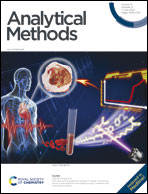A fast and simple extraction method for analysing levoglucosan and its isomers in sediments by ion chromatography tandem mass spectrometry†
Abstract
The ability to trace current and past biomass burning events is important for understanding the links between human activity, fire frequency, and climate. One method of tracing biomass burning is to measure the concentrations of certain monosaccharides anhydrides (MAs), specifically levoglucosan (LEV) and its isomers, mannosan (MAN) and galactosan (GAL), which are products of cellulose and hemicellulose pyrolysis. This work presents a simple extraction method allowing for the rapid, sensitive, and selective determination of MAs in sediments. MAs detection was performed using suppressed ion chromatography with electrospray – triple-stage quadrupole tandem mass spectrometry (IC-TSQ-MS). The extraction method involves ultrasound probe sonication using water as the solvent. Extraction time, amplitude, and sonication mode were optimised. Recoveries higher than 86% for all MAs tested were achieved by applying 70% amplitude in continuous mode for 60 s. Analytical performance of the method included instrumental LODs of 0.10, 0.12 and 0.50 μg L−1 for LEV, MAN and GAL, respectively. No carryover issues, no matrix effect and no co-elution of targeted MAs with other sugars likely present in sediments samples were observed. The developed extraction method was further validated by the analysis of LEV and MAN in NIST® 1649b urban dust reference material and the resulting concentrations were in excellent agreement with previously reported values. MAs quantification in 70 lake sediment samples were carried out with concentrations found to range from 0.009 to 0.390 μg g−1 for LEV and from 0.009 to 0.194 μg g−1 for MAN. Plotting MAs concentrations versus approximate sediment age allowed the reconstruction of recent fire events impacting two locations in the Central Highlands of Tasmania, Australia.



 Please wait while we load your content...
Please wait while we load your content...